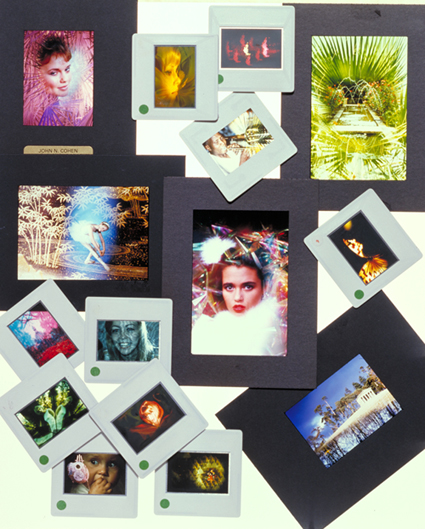|
The author created his pictures on Kodachrome transparecy
film, but many of these described images can also be taken with
digital cameras.
Projection Photography
The discovery of the basic technique was, as is often the
case, the result of an accident. It was the chance projection of a slide,
without having the screen in place, that resulted in a portrait appearing partly on some
fabric and partly on the wallpaper. The curved fabric distorted the image and
when the picture was clearly focussed the weave and texture of the materials forming a
type of screen became part of the portrait. This result was sufficiently
intriguing to leave the projection as it was, and to study the possibilities of this
occurrence.
Was it conceivable that a new photograph could be taken of the remarkable effect that
could now be seen? Why not? If this effect could be photographed
then one can photograph projected images on other textures, or even on other objects.
This odd happening has proved to be the basic approach to gain full control
of all images. Providing a completely new way of superimposing, and controlling
every aspect of the picture. Obviously, it is practical to rephotograph a
projected image, no matter what it is projected on to, if one can see it, one can
photograph it!
The projector however offers so many more possibilities than the darkroom enlarger to
create pictures. Take any image on any film, it is just as easy to project
negatives, or transparencies in colour, or black and white, on to whatever is desired.
Consider the potential when projecting an image on to; fabrics (not always
flat), textures, or even on to other objects, then try bouncing the projected photograph
off a reflective surface, and focus it on to a screen, or have a look at what happens if a
crystal is placed near to the projector lens (behind the lens as well as in
front).
Colour filters can be used, or parts of the image can be masked
(again
compare the results obtained in front, as against behind, the projector
lens).
With more than one projector it is possible to combine, and superimpose with perfect
control, more than one image. By projecting these images, one on top of the
other, and then masking away the overlapping parts of each image, that are no longer
required, a totally new picture can be formed.
These are the basic principles, which with infinite variety are used to mould, form and
relate at will, all that has ever been photographed. It is in fact the
projector that provides all the magic, such is the diversity that can be achieved with it.
The older type of projectors are often of more use, than the modern automatic
types, as it is then likely to be easier to gain access to the space behind the lens.
That facility is of great advantage with these techniques - so look out for
cheap second hand ones!
Return to
top of this page
|







